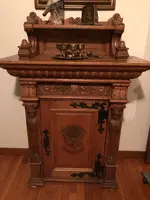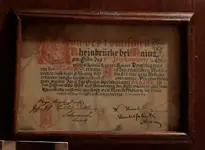ctalmadg
Sr. Member
- Joined
- Jul 27, 2003
- Messages
- 383
- Reaction score
- 228
- Golden Thread
- 0
- Location
- Honeoye Falls, NY (Fingerlakes Area)
- Detector(s) used
- White / Fisher / DJI Cellar Hole Detector
- Primary Interest:
- All Treasure Hunting
- #1
Thread Owner
Back in the 60's my Grandfather picked up this piece of furniture that is either a podium like piece or maybe a bar for booze. A old woman at a small roadside antique shop said she had gotten this from a old German couple that had came from Germany. My Mother said my Grandfather had paid maybe 30 dollars for it. For years I had looked at the plaque inside the door which was written in German.. Well recently I decided to have it translated and this is what transpired...
The translation is as follows:
From the Roman bridge over the Rhine River near Mainz, probably built under the rule of emperor Domitianus by the 14th Legion, at the end of the first century after Christ.
On the Roman supports, Karl the great (Charlemagne) , from 803 to 813, had a new bridge built. Scarcely completed, it burned completely.
The Roman support remains were removed from the river bed, by the District building directorate of Mainz, between The years of 1880 and 1882, for the improvement of the navigability of the Rhine river.
Wood from these bridge pylons was used in the making of this piece


After seeing this I was contacted by a German Archeologist<see below>..and what is interesting...He works for the museum that is listed on the plaque in the same town this piece was built in and also includes the museum founders signature. So it looks like his museums founder was involved somehow in the marketing of this piece..
"Rainer Schreg This Roman bridge crossing the Rhine at Mayence was built in 27 AD and was used up to the early 5th c. and repaired by Charlemagne. There is even a lead medallion. dating around 300AD depicting the bridge. After the Carolingian bridge burnt soon after its construction, the stone pillars of the bridge were used to tie ship mills. In the 19th c. the Rhine was prepared for shipping and all pillars including the wooden oak foundation were removed. It's known, that the Roman woods were used economically... There is a 19th c. fotograph showing a reconstruction of one of these wooden foundation in the courtyard of the nearby museum. What is new - at least to us, is that the founder of our museum was involved in the marketing. I will talk with some colleagues at our institute and at the local museum as well, to learn more about these pieces. Many thanks for your info and all these pics."
So i'm waiting hear from him regarding more info...
The translation is as follows:
From the Roman bridge over the Rhine River near Mainz, probably built under the rule of emperor Domitianus by the 14th Legion, at the end of the first century after Christ.
On the Roman supports, Karl the great (Charlemagne) , from 803 to 813, had a new bridge built. Scarcely completed, it burned completely.
The Roman support remains were removed from the river bed, by the District building directorate of Mainz, between The years of 1880 and 1882, for the improvement of the navigability of the Rhine river.
Wood from these bridge pylons was used in the making of this piece


After seeing this I was contacted by a German Archeologist<see below>..and what is interesting...He works for the museum that is listed on the plaque in the same town this piece was built in and also includes the museum founders signature. So it looks like his museums founder was involved somehow in the marketing of this piece..
"Rainer Schreg This Roman bridge crossing the Rhine at Mayence was built in 27 AD and was used up to the early 5th c. and repaired by Charlemagne. There is even a lead medallion. dating around 300AD depicting the bridge. After the Carolingian bridge burnt soon after its construction, the stone pillars of the bridge were used to tie ship mills. In the 19th c. the Rhine was prepared for shipping and all pillars including the wooden oak foundation were removed. It's known, that the Roman woods were used economically... There is a 19th c. fotograph showing a reconstruction of one of these wooden foundation in the courtyard of the nearby museum. What is new - at least to us, is that the founder of our museum was involved in the marketing. I will talk with some colleagues at our institute and at the local museum as well, to learn more about these pieces. Many thanks for your info and all these pics."
So i'm waiting hear from him regarding more info...








